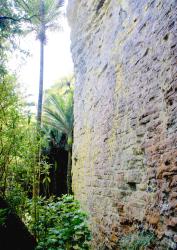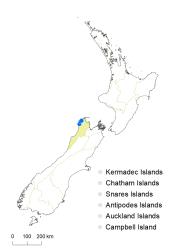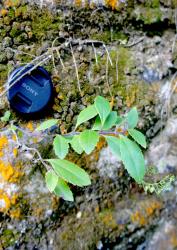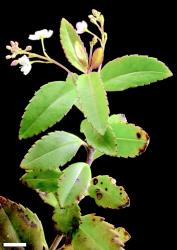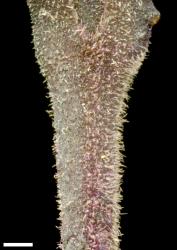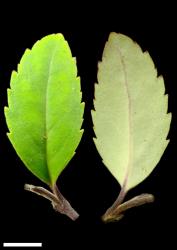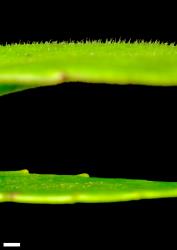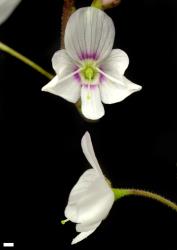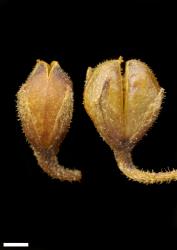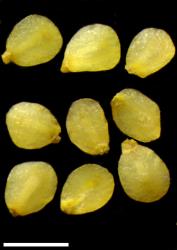- ≡ Parahebe senex Garn.-Jones in Garnock-Jones & Lloyd, New Zealand J. Bot. 42: 220 (2004)
Sub-shrub to 0.5 m tall. Stems decumbent to ascending or sometimes erect, eglandular-pubescent; hairs uniform, rarely bifarious or almost glabrous. Leaf bud indistinct; leaves separating while very small, opposite-decussate, erecto-patent to spreading; lamina sub-coriaceous, lanceolate, ovate, elliptic, obovate, or oblanceolate, 20–80 mm long, 10–38 mm wide, dull green or dark green above, pale green or sometimes pinkish or whitish beneath; midrib evident and lateral veins sometimes evident above; surfaces pubescent above and beneath or rarely glabrous; margin pubescent or rarely glabrous, bluntly serrate; teeth in 3–16 pairs; apex sub-acute or acute; base cuneate, petiole 3–7 mm long. Inflorescence a lateral raceme, 100–250 mm long; flowers distant, 10–40, all bisexual; bracts alternate, lanceolate, < pedicels; pedicels erecto-patent, incurved at fruiting, 8–21 mm long, pubescent all around. Calyx lobes 4, acute, 1.5–2.5 mm long, sub-equal to unequal, pubescent. Corolla 10–12 mm diameter; tube white and greenish yellow, 1–2 mm long, < calyx, eglandular-hairy inside; lobes 4, white, spreading, unequal, elliptic or oblong to orbicular, 4–5 mm long, rounded or sometimes posterior lobe emarginate; nectar guides magenta or pink. Stamen filaments white, 4 mm long; anthers white. Style glabrous, 3.0–4.5 mm long. Capsules angustiseptate to turgid, truncate to emarginate, pubescent or glabrous, 2–4 mm long, 2.5–3.5 mm at widest point. Seeds ellipsoid to obovoid, flattened, smooth, pale brown to brown, 0.6–1.0 mm long.
Veronica senex belongs among the speedwell hebes, a group distinguished by short corolla tubes, coloured nectar guides on the corolla, plicate lateral corolla lobes, lax inflorescences with long pedicels, and stamen filaments attenuate at the base. In this group of similar species, V. senex plants are most similar to V. catarractae plants and larger plants of V. lanceolata. V. catarractae and V. lanceolata differ from V. senex because their leaves are glabrous on the surfaces, although V. senex plants sometimes have glabrous leaves. V. senex inflorescences are pubescent without any long glandular hairs, and the pedicels are pubescent all around (in one line in V. catarractae). The dull, often dark green adaxial surfaces of their leaves are also distinctive. Larger plants of V. lanceolata often have narrower leaves than V. senex, while leaves of V. catarractae are white beneath and more coarsely toothed.
South Island: Western Nelson (Anatori River, Webb Stream, Pukatea Stream, Raukawa Stream, and Ryan Creek).
Limestone and calcareous sandstone cliffs and associated talus slopes. Recorded elevations range from 6 to 220 m.
Flowers: December–February: fruits: January–April, and old fruit present year round.
2n = approx. 42 (Dawson & Beuzenberg 2000, as Parahebe aff. catarractae).
Veronica senex is classified in V. subg. Pseudoveronica sect. Hebe and informally in the “speedwell hebe” group (Albach & Meudt 2010).



